February 2023 LIP of the Month
Deccan’s emplacement mechanism revealed from magnetic fabrics and dimension scaling of Narmada-Satpura-Tapi dyke swarm
Ayanangshu Das1,2, Garima Shukla1, Jyotirmoy Mallik1*
1 Geodynamics and Petroleum Geology Lab, Department of Earth and Environmental Sciences, Indian Institute of Science Education and Research Bhopal, Madhya Pradesh, India
2 presently at: Basin and Crustal Deformation Research Laboratory, Pusan National University, South Korea
* Corresponding author: jmallik@iiserb.ac.in
E-mail addresses: ayanangshudas073@gmail.com (A.Das), garima19@iiserb.ac.in (G. Shukla)
Extracted from:
- Das, A., Mallik, J., Banerjee, S., 2021. Characterization of the magma flow direction in the Nandurbar-Dhule Deccan dyke swarm inferred from magnetic fabric analysis. Phys. Earth Planet. Inter. 319, 106782. https://doi.org/10.1016/j.pepi.2021.106782
- Shukla, G., Mallik, J., Mondal, P., 2022. Dimension-scaling relationships of Pachmarhi dyke swarm and their implications on Deccan magma emplacement. Tectonophysics 843. https://doi.org/10.1016/j.tecto.2022.229602
Introduction
The Deccan Volcanic Province (DVP) of India (Fig. 1a), an archetype of continental flood basalt (CFB) province, played a phenomenal role in shaping the geodynamics of the Indian plate. CFB provinces commonly contain one or more discreet swarms of linear ridges formed by parallel, radiating or circumferentially oriented magmatic dykes (Ernst, 2014; Buchan and Ernst, 2019, 2021). Such dyke networks often act as feeders partially or entirely to the CFB (e.g., Elliot and Fleming, 2004; Walker, 1999) and manifest the prevalent stress conditions during their emplacement. The DVP is associated with three such mega dyke swarms, namely, the Narmada–Satpura-Tapi (NST) dyke swarm (E-W trending), the West Coast (WC) dyke swarm (N-S trending) and the (randomly oriented) Nasik–Pune (NP) dyke swarm, ( Deshmukh and Sehgal, 1988; Bondre et al., 2006; Fig. 1a). Nandurbar-Dhule (ND) dykes and Pachmarhi dykes mark the western and eastern parts of the NST dykes, respectively. The ND dykes swarm (~ 210 dykes) intrudes the highly weathered Deccan flood basalts whereas the Pachmarhi dykes intrude sedimentary rocks of Gondwana succession (consisting of sandstone, mudstone, boulders and shale).
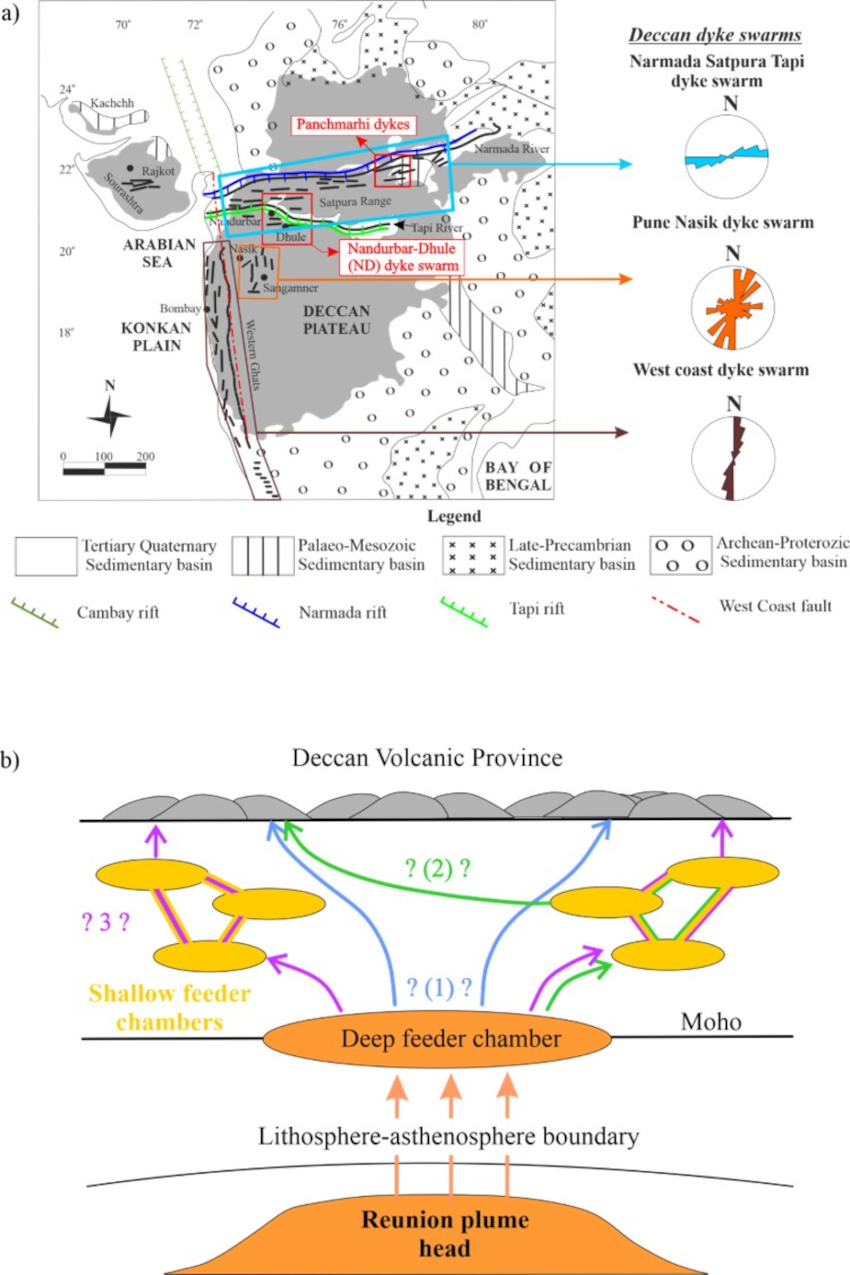
Fig. 1. a) Map of the Deccan Volcanic Province (DVP) with major tectonic features such as Cambay, Narmada and Tapi rift systems, West Coast fault etc. (Modified after Bhattacharjee et al., 2004; Ray et al., 2007). The field area i.e., Dhule-Nandurbar Deccan (DND) dyke swarm and Pachmarhi swarm, part of larger Narmada-Satpura-Tapi dyke swarm, is highlighted with red square. Dyke orientation from each of the dyke swarms are shown. b) Scenarios for the emplacement of the DVP as a direct or indirect result of the impingement of the Réunion mantle plume head on the lithosphere: emplacement of the DVP directly from a subcrustal igneous layer (scenario 1 in blue; Singh et al., 2014), from shallow feeder chambers below the (scenario 2 in green and scenario 3 in purple; Mittal & Richards, 2021).
Generally, magma upwells from the plume head or underplated magma chambers to the surface through pre-existing or coeval fractures formed by tectonic extension (e.g., Acocella et al., 2003; Valentine and Krogh, 2006). Such fracture systems of magma conduits often preserve themselves as dyke and/or sills (e.g., Martin et al., 2019; Mathieu et al., 2008; Putirka, 2017 and references therein). In terms of geodynamics, it has long been thought that CFB eruptions are fed by a deep, medium to large (105–106 km3) magma reservoir which is the Réunion plume in the case of DVP (scenario 1 from Fig. 1b; Black and Manga, 2017). However, many recent workers ( Bhattecharji et al., 2004; Ray et al., 2007; Singh et al., 2014; Mittal and Richards, 2021) proposed that CFB eruptions may have been fed by several interconnected small-medium (102–103 km3) magma reservoirs within the crust (scenarios 2–3 from Fig. 1b). In large radiating dyke swarms, the magma is generally thought to be fed via lateral injection from the plume centre region (e.g. Ernst and Baragar 1992; Baragar et al. 1996; Hastie et al. 2014; Ernst et al. 2019), and this might even apply in some rift related swarms such as the Okavanga swarm of the Karoo LIP (Hastie et al. 2014). Our recent two publications (Das et al.,2021 and Shukla et al., 2022) contribute further to the debate around the emplacement mechanism of Deccan volcanism. In Das et al., 2021a, we have demonstrated with the aid of magnetic fabric, that flow directions remain largely vertical in case of ND dyke swarm which is typically observed in case of emplacement from shallow magma chambers. In Shukla et al., 2022, we have calculated the depth of the magma chambers from the aspect ratios of the dykes and again concluded largely shallow emplacement.
Discussion:
The Anisotropy of Magnetic Susceptibility (AMS) was used to constrain the flow geometry of the ND dyke swarm (Das et al., 2021a). The study was further complemented with detailed petrography (both under optical and scanning electron microscope), and rock magnetic analysis (e.g., Hysteresis loop, temperature-dependent susceptibility analysis) to identify the magnetic mineralogy and domain structure which are prerequisites for robust AMS data interpretation. Multidomain-dominated titano-magnetite was identified to be the primary remanence carrier. We carried out methodical documentation of the magnetic fabric along both the margins of fifteen DND dykes (Das et al., 2021a). Imbrications of magmatic fabrics along the margins are used to determine the absolute flow directions. We inferred that the majority of the studied dykes are dominated by sub-vertical to inclined flow with randomly oriented primary flow axes (for inclined flows). However, we also reported the rare sub-horizontal flow in a few dykes (Fig. 2) attributed to the widening of surface aperture of the dykes due to thermal erosion. The dominance of sub-vertical flow, and lack of preferred orientation of magma flow pattern in the case of inclined flows (Fig. 3) indicated the possibility of emplacement from several shallow magma chambers (polycentric flow), which in a way supports the ‘fissure fed’ theory for Deccan volcanism as indicated by some other recent authors (Ray et al., 2007; Sheth et al., 2009; Vanderklyusen et al., 2011; Sheth et al., 2019; Kale et al., 2020).
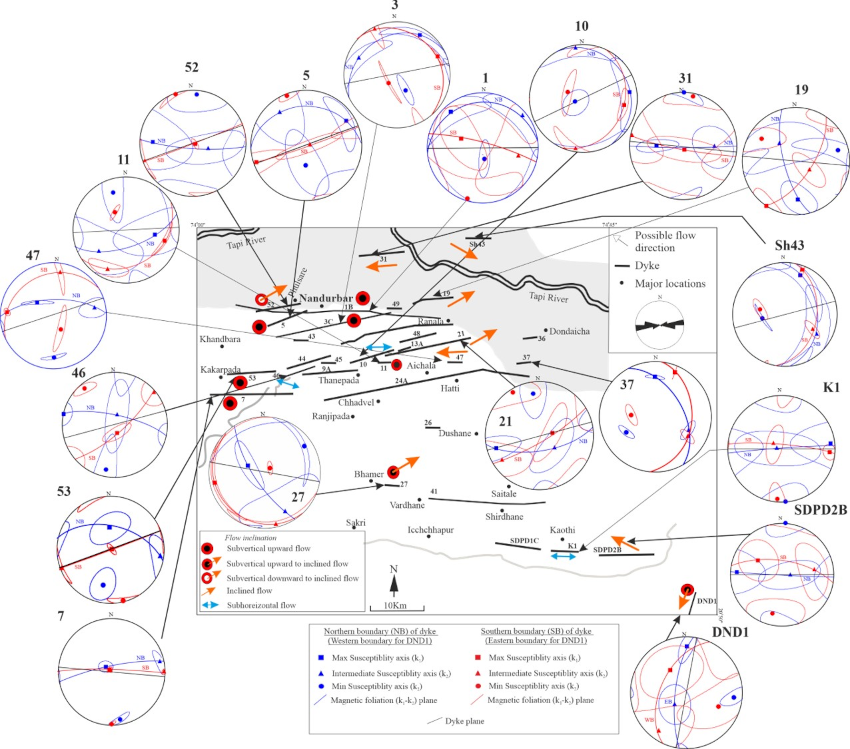
Fig. 2. Map of ND dyke swarm showing the studied dykes and inferred flow direction. Stereonets show the possible imbrication of magnetic foliation plane from both the dyke margins with respect to the dyke plane. Inferred flow direction manifests the dominance of subvertical to inclined flow with randomly aligned primary flow axis. Very rare occurrence of sub-horizontal flow is also shown. (Adopted from Das et al., 2021).
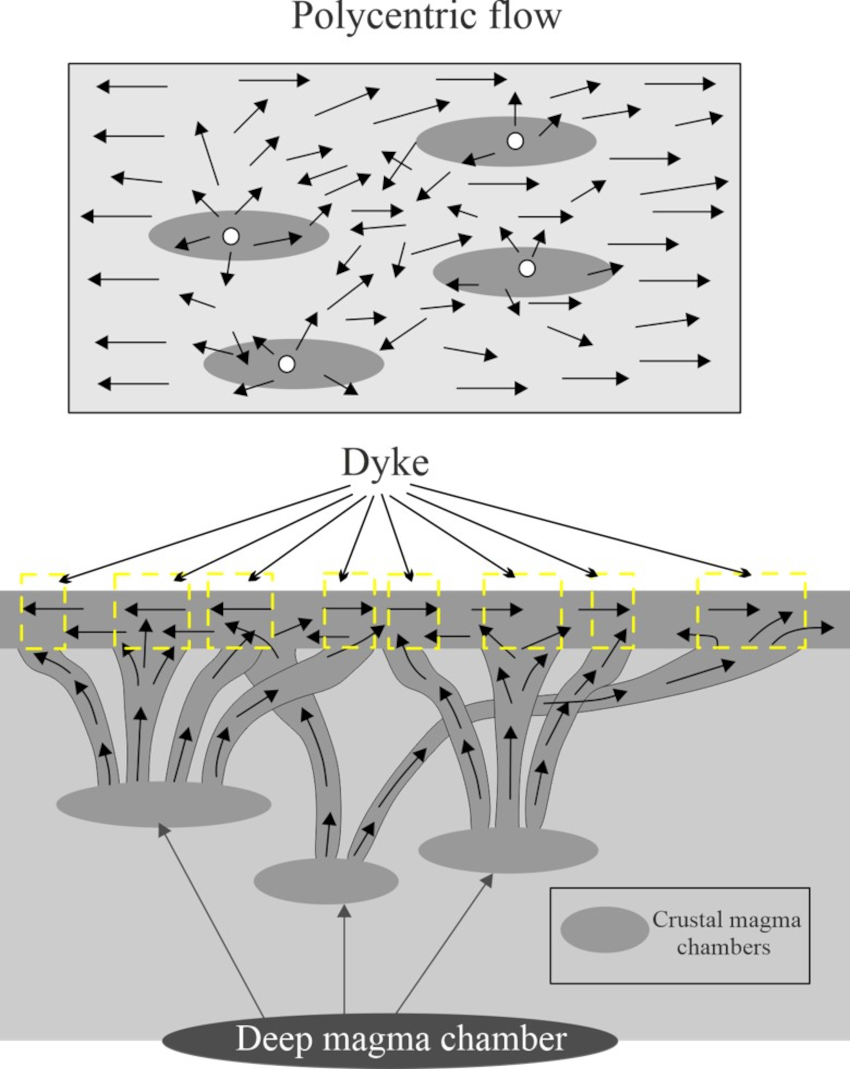
Fig. 3. Conceptualized diagram explaining the random distribution of primary flow axis in case of polycentric flow as a consequence of multiple shallow crustal feeder chambers.
In Shukla et al. (2022), We measured the length, thickness and structural attitudes of the Pachmarhi dykes. The Pachmarhi dykes are sub-vertical (dip >80◦) and mostly oriented along ~ENE-WSW or ~ E-W (Fig. 4a), marking strong alignment with the Narmada- Son lineament. The calculated magmatic overpressures and depth of magma chambers were further compared with ND dykes and the Proterozoic Newer Dolerite dykes of Singhbhum Craton of Eastern India.
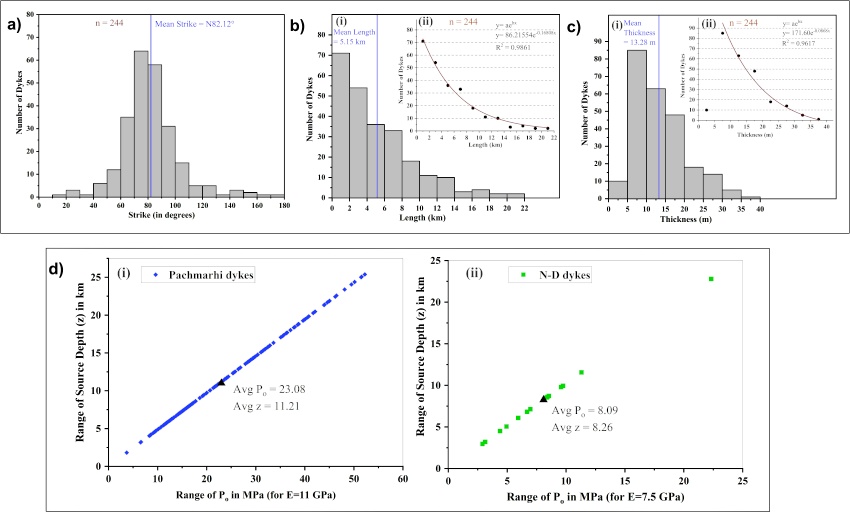
Fig. 4. a) Histogram distribution curve for Pachmarhi dykes, with a mean strike of N82°E. b) (i) Histogram distribution of dyke length. (ⅱ) The fitting curve of dyke length shows an exponential law distribution (the general formula is ), in which the coefficient of determination (R2) is about 0.98. c) (i) Histogram distribution for thickness of Pachmarhi dykes (ⅱ) The fitting curve of dyke thickness shows an exponential law distribution (the general formula is ), in which the coefficient of determination (R2) is about 0.96. d) Scatter plot showing the range of magma source depth (z) versus magmatic Overpressure (Po). (i) for Pachmarhi dykes (n = 165). (ⅱ) for Nandurbar-Dhule dykes (n = 15)
Compared to Nandurbar-Dhule dykes (maximum length of 79 km; Ray et al., 2007), Pachmarhi dykes are generally shorter in length (maximum length of 21.47 km). Seventy per cent of the dykes are less than 10 km in length, while 50 % dykes are lesser than 5 km in length (Fig. 4b). The mean thickness for 244 measured dykes is 13.28 m whereas the median is 12.05 m (Fig. 4c). The aspect ratio (dyke length: thickness ratio) of Pachmarhi dykes varies from a minimum of 11.93 to a maximum of 2384.92. The aspect ratios of the Nandurbar-Dhule dykes are very different from the Pachmarhi dykes, as the long dykes of Nandurbar-Dhule are significantly longer than the long dykes of Pachmarhi (maximum aspect ratio of 11,630:1, with an average of 1493:1).
The aspect ratio of the dykes in combination with the mechanical properties of the host rock is taken into account to determine the magmatic overpressure and the source depth of the magma chamber. Eq. (1) is used to calculate magmatic overpressure; Po (Babiker and Gudmundsson, 2004; Becerril et al., 2013) for the dykes generated by Mode I fractures where the length of the dyke (L) is less than the dip dimension (height above the magma chamber) and the thickness of the dyke is controlled by the length of the dyke (L):
|
(1) |
where, bmax is the maximum thickness of the dyke, E and ν are young’s modulus and Poisson’s ratio of the host rock respectively, while P0 is the magmatic overpressure responsible for opening the cracks during the emplacement of the dykes.
Eq. (2) has been used to estimate the source depth of the magma chamber (z) using the magmatic overpressures (Po) similar to that of the Iceland dykes by Gudmundsson (1983), also for the Nandurbar-Dhule (ND) dykes by Ray et al. (2007).
|
(2) |
where, ρr is the average density of the crustal rock, ρm is the density of the magma, g is the acceleration due to gravity (9.8 m/s2), Po is the overpressure of the magma and z is the source depth of the magma chamber that is supplying magma to the dykes.
The estimated magmatic overpressure (Po) for Pachmarhi dykes having a strike dimension smaller than or equal to the dip dimension, varies in the range of 2.36 MPa to 33.23 MPa, with an average of 14.68 MPa (considering Young’s modulus, E=7 GPa), 5.05 MPa to 71.21 MPa, with an average of 31.46 MPa (considering E= 15 GPa) and 3.71 MPa to 52.22 MPa, with an average of 23.08 MPa (considering E=11 GPa), in all cases the value of Poisson’s ratio was 0.29. The depth range of magma chamber (z) for Pachmarhi dykes varies between 1.15 km to 16.15 km with average of 7.14 km (for E=7 GPa), and 2.46 km to 34.61 km with average of 15.3 km (for E=15 GPa) and for average E=11 GPa, the minimum, average and maximum depths are 1.81 km, 11.21 km and 25.38 km, respectively. For ND dykes source depth varies from 2.96 to 22.8 km (average of 8.26 km) for average young’ modulus value of 7.5 GPa (Fig. 4d; Ray et al. 2007). The average depth of 8.26 km is analogous to the results of petrological and gravity modelling for the Narmada- Tapi rift by Bhattacharji et al. (2004).
Both our studies suggest that it is more likely that there are multiple connected small reservoirs of magma instead of a larger one that supplies magma to the surface through dykes and sills, with each of the magma reservoirs undergoing the REAFC (Recharge-Eruption-Assimilation-Fractional crystallization) process (Fig. 5) feeding NST dykes and associated DVP. Such multiple shallow crustal chambers are also reported from previous gravity modelling (Bhattacharji et al., 2004) study.
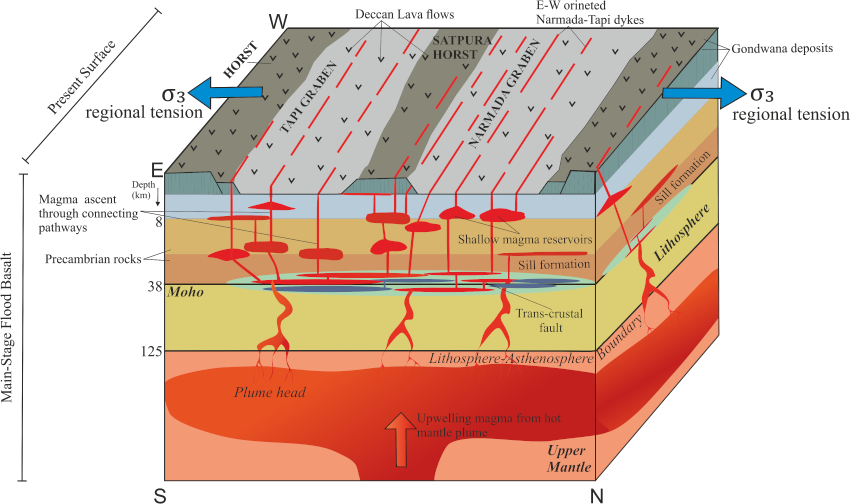
Fig. 5. Main Stage Deccan Flood basalt with multiple smaller magma reservoirs interconnected through pathways and undergoing REAFC (Recharge-Eruption-Assimilation-Fractional crystallization) process ( adapted from Mittal et al. (2021) and Mittal and Richards (2021). Shukla et al. (2022) have concluded that Pachmarhi dykes and ND dykes exhibit such a type of magmatic system as the source depth of the magma chambers supports this particular model. The Pachmarhi dykes are oriented towards ~E-W direction perpendicular to the direction (direction of regional tension). The present surface shows Satpura horst and Narmada-Tapi graben with Deccan lava flows and dykes.
Pre or syn-Deccan crustal extension can very well be a consequence of an interplay between mantle plume push and large-scale intercontinental plate tectonics. The already recorded Late-Cretaceous high plate velocity (15-20 cm/year; Das, 2021b; Jagoutz et al., 2015) could have led to fracturing of the crustal weak zones along the intercontinental rifts (e.g., Narmada-Son-Tapi Lineament) inducing intense crustal extension creating potential fracture conduits parallel to the rift. The Deccan flood basalts were possibly emplaced through such conduits (dykes).
References:
Acocella, V., Korme, T., Salvini, F., Funiciello, R., 2003. Elliptic calderas in the Ethiopian Rift: Control of pre-existing structures. J. Volcanol. Geotherm. Res. 119, 189–203. https://doi.org/10.1016/S0377-0273(02)00342-6
Babiker, M., Gudmundsson, A., 2004. Geometry, structure and emplacement of mafic dykes in the Red Sea Hills, Sudan. J. African Earth Sci. 38, 279–292. https://doi.org/10.1016/j.jafrearsci.2004.01.003
Baragar, W.R.A., Ernst, R.E., Hulbert, L., Peterson, T., 1996. Longitunal petrochemical variations in the Mackenzie dyke swarm, north western Canadian shield. J. Petrl. 37, 317-359.
Becerril, L., Galindo, I., Gudmundsson, A., Morales, J.M., 2013. Depth of origin of magma in eruptions. Sci. Rep. 3. https://doi.org/10.1038/srep02762
Bhattacharji, S., Sharma, R., Chatterjee, N., 2004. Two- and three-dimensional gravity modeling along western continental margin and intraplate Narmada-Tapti rifts: Its relevance to Deccan flood basalt volcanism. Proc. Indian Acad. Sci. Earth Planet. Sci. 113, 771–784. https://doi.org/10.1007/BF02704036
Black, B.A., Manga, M., 2017. Volatiles and the tempo of flood basalt magmatism. Earth Planet. Sci. Lett. 458, 130–140. https://doi.org/10.1016/j.epsl.2016.09.035
Bondre, N.R., Hart, W.K., Sheth, H.C., 2006. Geology and geochemistry of the Sangamner mafic dike swarm, western Deccan Volcanic Province, India: Implications for regional stratigraphy. J. Geol. 114, 155–170. https://doi.org/10.1086/499568
Buchan, K.L., Ernst, R.E., 2021. Plumbing systems of large igneous provinces (LIPs) on Earth and Venus: Investigating the role of giant circumferential and radiating dyke swarms, coronae and novae, and mid-crustal intrusive complexes. Gondwana Res. 100, 25–43. https://doi.org/10.1016/j.gr.2021.02.014
Buchan, K.L., Ernst, R.E., 2019. Giant circumferential dyke swarms: Catalogue and characteristics, in: Srivastava, R.K., Ernst, R.E., Peng, P. (Eds.), Springer Geology. Springer Singapore, Singapore, pp. 1–44. https://doi.org/10.1007/978-981-13-1666-1_1
Das, A., Mallik, J., Banerjee, S., 2021a. Characterization of the magma flow direction in the Nandurbar-Dhule Deccan dyke swarm inferred from magnetic fabric analysis. Phys. Earth Planet. Inter. 319. https://doi.org/10.1016/j.pepi.2021.106782
Das, A., Mallik, J., 2021b. Geodynamics related to late-stage Deccan volcanism : Insights from paleomagnetic studies on Dhule-Nandurbar ( DND ) dyke swarm Geodynamics related to late-stage Deccan volcanism : Insights from paleomagnetic studies on Dhule-Nandurbar ( DND ) dyke swarm.
Deshmukh, S.S., Sehgal, M.N., 1988. Mafic dyke swarms in Deccan Volcanic Province of Madhya Pradesh and Maharashtra. Mem. - Geol. Soc. India 10, 323–340.
Elliot, D.H., Fleming, T.H., 2004. Occurrence and dispersal of magmas in the Jurassic Ferrar Large Igneous Province, Antarctica. Gondwana Res. 7, 223–237. https://doi.org/10.1016/S1342-937X(05)70322-1
Ernst, R.E., 2014. Large igneous provinces, in: Cambridge University Press. p. 653.
Ernst, R.E., Baragar, W.R.A., 1992. Evidence from magnetic fabric for the flow pattern of magma in the Mackenzie giant radiating dyke swarm. Nature 356, 511-513. https://doi.org/10.1038/356511a0
Ernst, R.E., Liikane, D.A., Jowitt, S.M., Buchan, K.L., Blanchard, J.A., 2019. A new plumbing system framework for mantle plume-related continental Large Igneous Provinces and their mafic-ultramafic intrusions. J. Volcanol. Geother. Res. 384, 75-84. https://doi.org/10.1016/j.jvolgeores.2019.07.007
Gudmundsson, A., 1983. Form and dimensions of dykes in eastern Iceland. Tectonophysics 95, 295–307. https://doi.org/10.1016/0040-1951(83)90074-4
Hastie, W.W., Watkeys, M.K., Aubourg, C., 2014. Magma flow in dyke swarms of the Karoo LIP: Implications for the mantle plume hypothesis. Gond. Res. 25, 736-755. http://dx.doi.org/10.1016/j.gr.2013.08.010
Jagoutz, O., Royden, L., Holt, A.F., Becker, T.W., 2015. Anomalously fast convergence of India and Eurasia caused by double subduction. Nat. Geosci. 8, 475–478. https://doi.org/10.1038/NGEO2418
Kale, V.S., Bodas, M., Chatterjee, P., Pande, K., 2020. Emplacement history and evolution of the Deccan Volcanic Province, India. Episodes 43, 278–299. https://doi.org/10.18814/EPIIUGS/2020/020016
Martin, S.A., Kavanagh, J.L., Biggin, A.J., Utley, J.E.P., 2019. The origin and evolution of magnetic fabrics in mafic sills. Front. Earth Sci. 7, 1–23. https://doi.org/10.3389/feart.2019.00064
Mathieu, L., van Wyk de Vries, B., Holohan, E.P., Troll, V.R., 2008. Dykes, cups, saucers and sills: Analogue experiments on magma intrusion into brittle rocks. Earth Planet. Sci. Lett. 271, 1–13. https://doi.org/10.1016/j.epsl.2008.02.020
Mittal, T., Richards, M.A., 2021. The Magmatic Architecture of Continental Flood Basalts: 2. A New Conceptual Model. J. Geophys. Res. Solid Earth 126. https://doi.org/10.1029/2021JB021807
Putirka, K.D., 2017. Down the crater: Where magmas are stored and why they Erupt. Elements 13, 11–16. https://doi.org/10.2113/gselements.13.1.11
Ray, R., Sheth, H.C., Mallik, J., 2007. Structure and emplacement of the Nandurbar-Dhule mafic dyke swarm, Deccan Traps, and the tectonomagmatic evolution of flood basalts. Bull. Volcanol. 69, 537–551. https://doi.org/10.1007/s00445-006-0089-y
Sheth, H.C., Ray, J.S., Ray, R., Vanderkluysen, L., Mahoney, J.J., Kumar, A., Shukla, A.D., Das, P., Adhikari, S., Jana, B., 2009. Geology and geochemistry of Pachmarhi dykes and sills, Satpura Gondwana Basin, central India: Problems of dyke-sill-flow correlations in the Deccan Traps. Contrib. to Mineral. Petrol. 158, 357–380. https://doi.org/10.1007/s00410-009-0387-4
Sheth, H., Vanderkluysen, L., Demonterova, E.I., Ivanov, A. V., Savatenkov, V.M., 2019. Geochemistry and 40 Ar/ 39 Ar geochronology of the Nandurbar-Dhule mafic dyke swarm: Dyke-sill-flow correlations and stratigraphic development across the Deccan flood basalt province. Geol. J. 54, 157–176. https://doi.org/10.1002/gj.3167
Shukla, G., Mallik, J., Mondal, P., 2022. Dimension-scaling relationships of Pachmarhi dyke swarm and their implications on Deccan magma emplacement. Tectonophysics 843. https://doi.org/10.1016/j.tecto.2022.229602
Singh, B., Prabhakara Rao, M.R.K., Prajapati, S.K., Swarnapriya, C., 2014. Combined gravity and magnetic modeling over pavagadh and phenaimata igneous complexes, gujarat, india: Inference on emplacement history of deccan volcanism. J. Asian Earth Sci. 80, 119–133. https://doi.org/10.1016/j.jseaes.2013.11.005
Valentine, G.A., Krogh, K.E.C., 2006. Emplacement of shallow dikes and sills beneath a small basaltic volcanic center - The role of pre-existing structure (Paiute Ridge, southern Nevada, USA). Earth Planet. Sci. Lett. 246, 217–230. https://doi.org/10.1016/j.epsl.2006.04.031
Vanderkluysen, L., Mahoney, J.J., Hooper, P.R., Sheth, H.C., Ray, R., 2011. The feeder system of the Deccan Traps (India): Insights from dike geochemistry. J. Petrol. 52, 315–343. https://doi.org/10.1093/petrology/egq082
Walker, G.P.L., 1999. Volcanic rift zones and their intrusion swarms. J. Volcanol. Geotherm. Res. 94, 21–34. https://doi.org/10.1016/S0377-0273(99)00096-7
